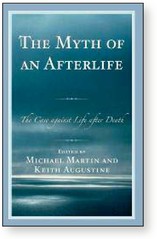
Rowman & Littlefield, 2015. 708 pp. $85 ISBN 978-0-8108-8677-3
IF THEY WERE AIMING FOR SUCCESS AND popularity, the editors of The Myth of an Afterlife have obviously not been paying attention to current trends in publishing that have given us such books as Heaven is for Real, Proof of Heaven, Evidence of the Afterlife, and Consciousness Beyond Life.1 On the other hand, there was clearly a niche waiting to be filled by books skeptical of the immortality of the soul and the existence of the afterlife. But it turns out there are not so many of those. Perhaps this asymmetry reveals a peculiarity of the human mind: somehow the hypothesis that we do survive bodily death is more appealing than the alternative.
Not editors to surrender to popular pressure, philosophers Keith Augustine and the late Michael Martin took it upon themselves to assemble a team of 29 valiant contributors to attack the afterlife “myth.” The result is an impressive volume composed of 30 essays, spanning 675 pages and organized in four parts. Part 1 addresses “empirical arguments for annihilation,” i.e., “the position that persons permanently cease to exist at biological death” (2). As it turns out, these arguments really amount to the daily bread and butter of cognitive neuroscientists, and thus this portion of the book reads like a crashcourse in brain science. The “argument from brain damage,” for instance, uses neuropsychological evidence to show that “the destruction of the mind by the destruction of the brain is highly probable given the hypothesis that the mind depends entirely upon the functioning of the brain, but is highly improbable given the hypothesis that the mind can exist and operate independently of the brain.” If all brain functions have been turned off, “what’s left for a soul to do?” (121).